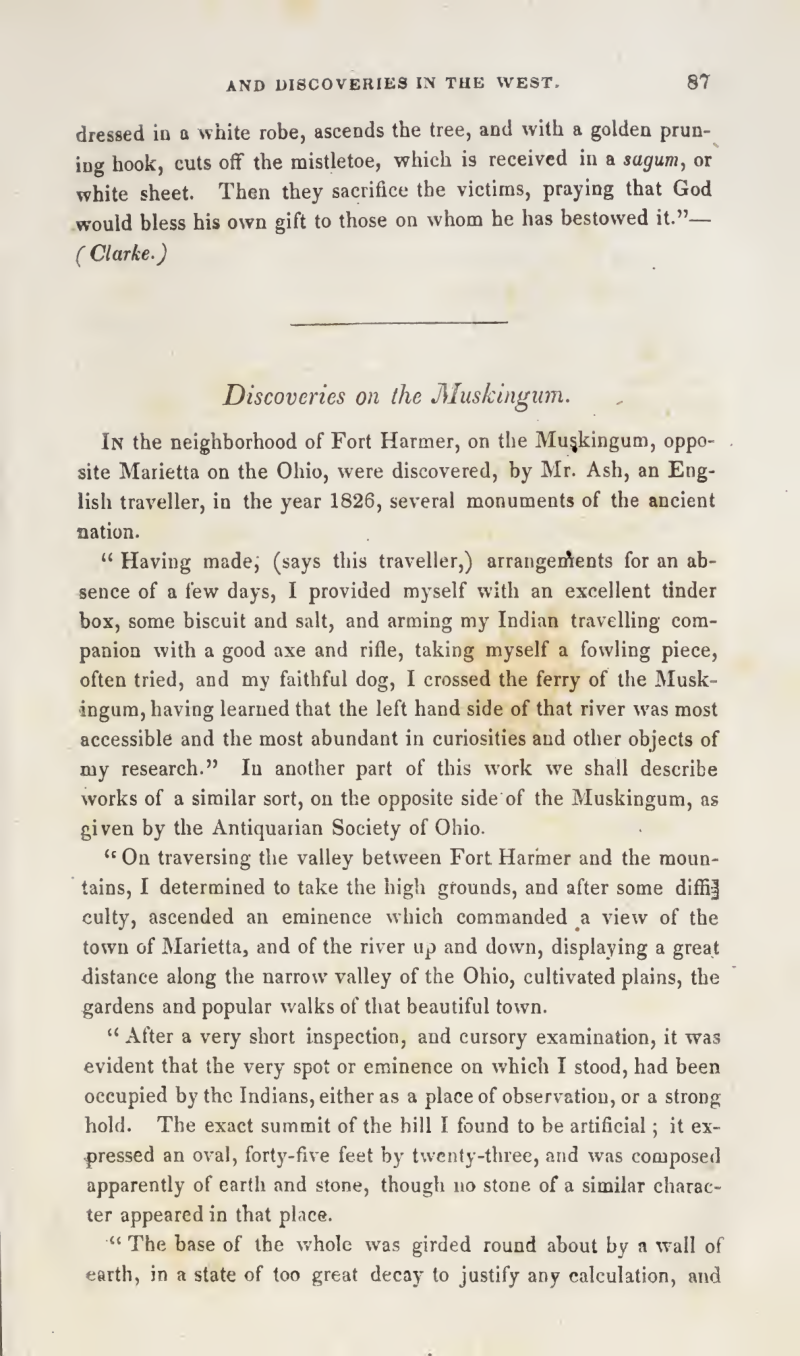Josiah Priest reprints story of a "Mr. Ash" discovering hidden treasure in 1826.
- Type
- Book
- Source
- Josiah Priest Non-LDS
- Hearsay
- UnsourcedSecondary
- Reference
Josiah Priest, American Antiquities and Discoveries in the West (Albany: Hoffman & White, 1834), 87-90
- Scribe/Publisher
- Hoffman & White
- People
- Mr. Ash, Josiah Priest
- Audience
- Reading Public
- Transcription
In the neighborhood of Fort Harmer, on the Muskingum, opposite Marietta on the Ohio, were discovered, by Mr. Ash, an English traveller, in the year 1826, several monuments of the ancient nations.
"Having made, (says this traveller,) arrangements for an absence of a few days from the fort, I provided myself an excellent tinder box, some biscuit and salt, and arming my Indian travelling companion, with a good axe and rifle, . . .On traversing the valley between Fort Harmer and the mountains, I determined to take the high grounds, and after some difficulty, ascended an eminence which commanded a view of the town of Marietta, . . . After a very short inspection, and cursory examination, it was evident that the very spot or eminence on which I stood, had been occupied by the Indians, either as a place of observation, or a strong hold. . . . I despaired of gaining any further knowledge, and would have left the place, had I not been detained by my Indian companion, whom I saw occupied in end[e]avoring to introduce a pole into a small opening between two flat stones, near the root of a tree, which grew on the very summit of this eminence.
"The stones we found were too heavy to be removed by the mere power of hands. Two good oak poles were cut, in lieu of levers and crows. Clapping these into the orifice first discovered, we weighed a large flat stone, tilting it over, . . . I expected to find a cavern: my imagination was warmed by a certain design I thought I discovered from the very beginning; the manner the stones were placed led me to conceive the existence of a vault filled with the riches of antiquity, and crowded with the treasures of the most ancient world.
"A bed of sand was all that appeared under these flat stones, . . . the sand was about a foot deep, which I soon removed.
"The design and labor of man was not unequivocal. The space out of which these materials were taken, left a hollow in an oblong square, lined with stones on the end and sides, and also paved on what appeared to be the end and sides, and also paved on what appeared to be the bottom, with square stones, of about nine inches diameter. . . . With the skeleton was found, first, an earthen vessel, or urn, in which were several bones, and some white sediment. . . . Sixth; under a heap of dust and tenuous shreds of feathered cloth and hair, a parcel of brass rings, cut out of a solid piece of metal, and in such a manner that the rings were suspended form each other, without the aid of solder or any other visible agency whatever. Each ring was three inches in diameter, and the bar of the rings a half an inch thick, and were square; a variety of characters were deeply engraved on the sides of the rings, resembling the Chinese characters.
- Citations in Mormonr Qnas
The B. H. Roberts Foundation is not owned by, operated by, or affiliated with the Church of Jesus Christ of Latter-day Saints.

